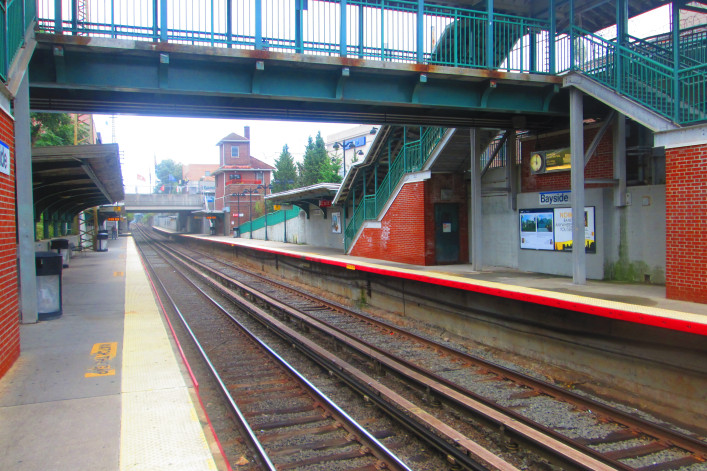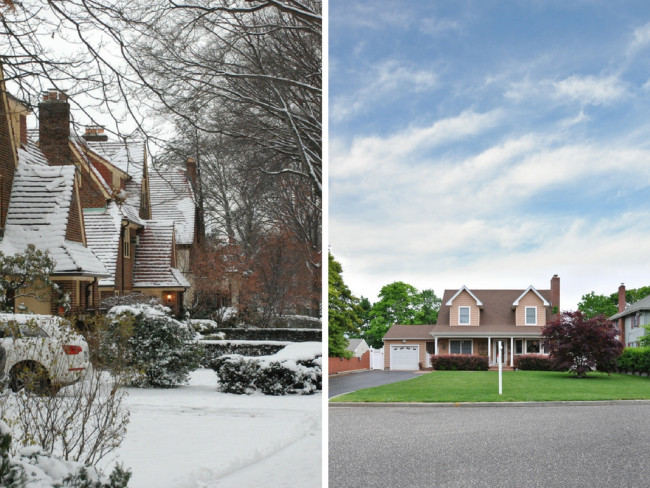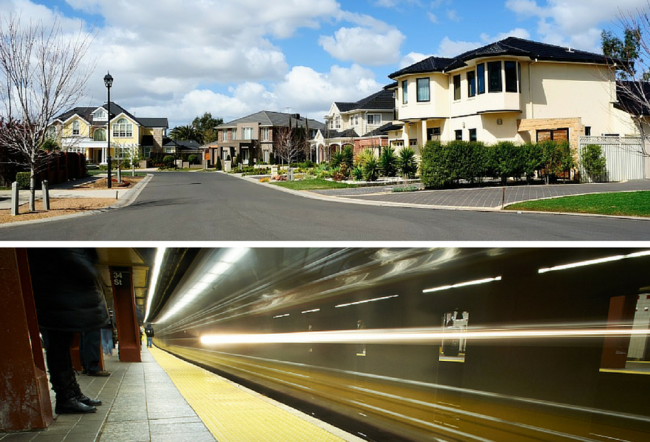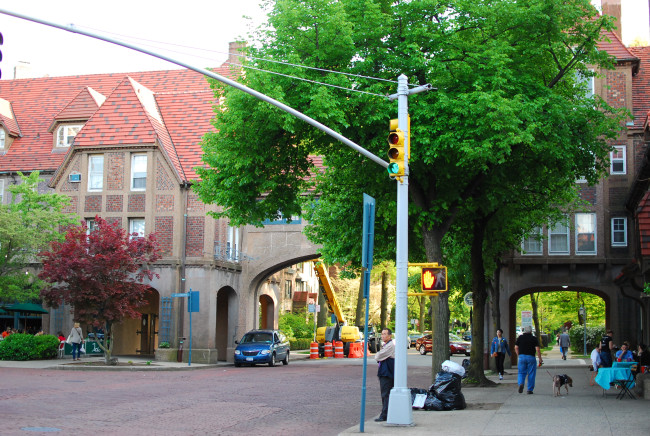Subway-less NYC: How neighborhoods thrive—or not—without direct subway connections

Bayside, Queens, has an LIRR station, but you're out of luck if you're looking for a subway. Adam Moss
Living near a subway doesn't always guarantee a swift journey to wherever you're headed. As Gothamist reported last month, the latest stats from the MTA reveal that mass transit delays—many of them from overcrowding—are only getting worse. In November, for instance, some trains were running on schedule less than 40 percent of the time.
A slow subway, though, seems better than none. Last year, Chris Whong of the Department of City Planning created a map of the city's "subway deserts"—that is, areas that are a 10-minute walk or more from the nearest station—and found that large swaths of the boroughs are underserved. Eastern Queens and the northern Bronx, in particular, include many neighborhoods that lie beyond the reach of the city's 472 subway stops.
A New York Times article links poor transit access to lower incomes and higher rates of unemployment, noting that the people who stand to benefit the most from easily reachable subways are less likely to be able to afford living in a neighborhood that offers them.
But at the same time, some New Yorkers would rather live off the subway grid. In Red Hook, for instance, locals have spoken out against the prospect of streetcar service coming to the south Brooklyn area, saying they prefer to stay under the radar rather than see their home become the next hot NYC neighborhood.
So how do residents in these places make it work? And do neighborhoods like Bayside, Whitestone, and Riverdale have something to offer that makes up for the lack of public transit?
Getting around: to drive or not to drive?
The Times article on subway deserts suggests that most residents of such places rely instead on bus service. But in the more suburban corners of the city, cars are often the norm.
For instance, when Nick Fasulo moved from Astoria to Bayside—a neighborhood of eastern Queens that's over 3.5 miles from the nearest subway station in Flushing—he knew he'd have to buy a car. He uses it to get around the neighborhood, visit car-less friends back in Astoria, and, on weekdays, drive to Bayside's Long Island Rail Road station. From there, it's a 24-minute ride to Penn Station (provided the LIRR is running smoothly), and about a 20-minute walk to work. From door to door, he says, the commute typically takes him a little over an hour.
"It's probably tough," he says, of living in Bayside without a car, but notes that he does see plenty of buses around town. (The MTA bus map reveals several bus lines along Bayside's main thoroughfares of Bell, Francis Lewis, and Northern Boulevards, though that still leaves sizeable chunks of the neighborhoods sans bus or subway options.) He adds that finding parking in Bayside is easy for drivers, and that most people rely on street parking rather than lots.
Christian Nacpil, a broker with Citi Habitats who has lived in Bayside for 15 years, says he commutes to Manhattan by taking the bus to the LIRR, but that there seems to be an even split between locals who drive and who rely on public transit. "A lot of people commute out to Long Island, so they're either driving to work there or commuting via bus and train to Manhattan," he says.
The situation is similar in Whitestone, Queens, which is northwest of Bayside. Paula Manna works for Citi Habitats and lives in Whitestone; she also attended high school and college in Queens, and recalls that most people she knew had cars. "It's more suburban, and not easy with the transit," she says, "but people are accustomed to driving around and walking to the store."
There's also the option of taking express buses to get to Manhattan: The QM2, for instance, brings passengers from Whitestone to Midtown in under an hour. There are local buses as well; Manna notes that her fiance takes a bus to the Bayside LIRR stop and commutes from there.
In the Bronx, Riverdale residents may find themselves with several alternatives to choose from. Sid Whelan, a broker with CORE, notes that there are many small sub-neighborhoods within Riverdale; those to the east of the Henry Hudson Parkway aren't too far from the 1 train, while those to the west are at least a mile away from the nearest stop.
In these areas, he says, people tend to use the neighborhood's Metro-North station, from which it's about a half hour ride to Grand Central.
Some developments, too, try to make a move to Riverdale worth it for tenants by helping to ease their commutes. "There's a huge diversity of amenities in terms of buildings," Whelan says. "Some will have a shuttle bus to the Metro-North, in addition to things like pools and great views." Other properties make driving easy by offering parking garages or on-site Zipcars.
The upside to life beyond the subway
Across the board, residents of the subway-less corners of NYC say that life beyond the subway has the same major advantages as the suburbs: a quieter, more relaxed pace of life, more space to spread out, and an overall "suburbs in the city" feel, minus the steep property taxes of Nassau or Westchester County.
For Manna, that blend is key to her choice to live in Whitesone. "I like the lifestyle of being able to park in front of my house and pay lower rent on a bigger place, where I can hang out and barbecue," she says. "It's about suburban amenities, but still living in the city."
And at the same time, there are stretches of the neighborhood that are walkable; Manna points to 150th Street and 14th Avenue, where there is plenty of shopping and restaurants. Because Whitestone has an extensive East River waterfront, there's also a handful of parks for riverside strolls.
Fasulo says that Bayside delivers a close-knit feel more commonly found in the burbs. Young families are drawn to the area because of Bayside High School, which, according to Inside Schools, has a high graduation rate and programs for high-achieving students. "There's a soccer field across the street from the school, with lots of teams playing and practicing once the weather warms up," Fasulo points out. "There's a great neighborhoody feel."
Riverdale, too, draws New Yorkers because of the quality of its local schools, Whelan says. Inside Schools writes that while Riverdale's area—District 10—is known for having overcrowded public schools, it's also the highest-performing district in the borough, and is near respected specialized public high schools like Bronx Science. There are also several esteemed private schools, like the Ethical Culture Fieldston School and Riverdale Country School, but of course, sending children there is a significant added expense.
While the east side of the highway has a busier, more city-like feel, Whelan says, the neighborhood is generally slower-paced and affords more privacy than what you'd find in Manhattan: "You will see lots of houses with big yards, where the neighbors are 30 yards away or more."
On the other hand, in a bid to attract younger buyers who might be leaving Manhattan and Brooklyn in search of greater affordability, some Riverdale co-ops are trying to brand themselves as places that foster a good social life. "Co-op boards are putting real thought into what they can to do make their buildings more fun and lifestyle-oriented, like putting in common rooms and gyms. We're seeing a lot more of that kind of thing," Whelan says.
But will you save on housing?
But are these neighborhoods more affordable? A RentHop map suggests that the more central the location, the higher the rent, but places like Bayside, Whitestone, and Riverdale aren't exactly cheap, despite being further from the heart of the city.
"Living in the city is expensive no matter where you are," says Whelan. "Apartments are selling much faster [in Riverdale]. The absorption rate has really drastically changed, and you're going to start seeing prices going up." Riverdale's status as an emerging market seems cemented by the fact that Douglas Elliman started tracking it in its most recent market reports.
Bayside, too, is a tough place if you're seeking bargains. "The fact that it has that suburban vibe and is also close to Long Island makes it a little pricier," Nacpil says. "But you can find a three- to four-bedrooms for under $1 million, or rent a floor of a house for about $3,000 a month, which is more real estate than you could get in Manhattan."
According to Zillow, Whitestone's market is also strong, with the median home price at $768,800. But, Manna says, you're getting a lot more bang for your buck in terms of square footage. "My fiance was complaining about our apartment until I took him to see places in Brooklyn," she recalls. "Now he thinks we live in a mansion."
You Might Also Like

























